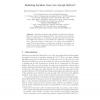112
click to vote
CATA
2004
15 years 1 months ago
2004
1 Decision Tree Induction is a powerful classification tool that is much used in practice and works well for static data with dozens of attributes. We adapt the decision tree conce...
AAAI
2006
15 years 1 months ago
2006
Most existing decision tree inducers are very fast due to their greedy approach. In many real-life applications, however, we are willing to allocate more time to get better decisi...
111
Voted
AAAI
2004
15 years 1 months ago
2004
Random decision tree is an ensemble of decision trees. The feature at any node of a tree in the ensemble is chosen randomly from remaining features. A chosen discrete feature on a...
116
Voted
SDM
2008
SIAM
15 years 1 months ago
2008
SIAM
Gene expression information from microarray experiments is a primary form of data for biological analysis and can offer insights into disease processes and cellular behaviour. Suc...
106
Voted
SDM
2010
SIAM
15 years 1 months ago
2010
SIAM
Gene prediction is one of the most challenging tasks in genome analysis, for which many tools have been developed and are still evolving. In this paper, we present a novel gene pr...
79
Voted
EMNLP
2007
15 years 1 months ago
2007
This paper compares a deep and a shallow processing approach to the problem of classifying a sentence as grammatically wellformed or ill-formed. The deep processing approach uses ...
103
click to vote
CLA
2007
15 years 1 months ago
2007
The paper presents a new method of decision tree induction based on formal concept analysis (FCA). The decision tree is derived using a concept lattice, i.e. a hierarchy of cluster...
128
Voted
AUSDM
2008
Springer
15 years 2 months ago
2008
Springer
Accurate and less invasive personalized predictive medicine can spare many breast cancer patients from receiving complex surgical biopsies, unnecessary adjuvant treatments and its...
109
click to vote
FLAIRS
2008
15 years 2 months ago
2008
In machine learning, decision trees are employed extensively in solving classification problems. In order to design a decision tree classifier two main phases are employed. The fi...
108
click to vote
RSCTC
2000
Springer
15 years 4 months ago
2000
Springer
The main task in decision tree construction algorithms is to find the "best partition" of the set of objects. In this paper, we investigate the problem of optimal binary ...

